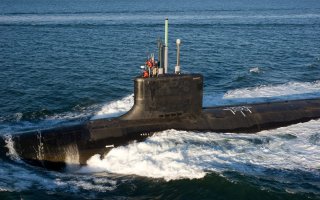The Horrific Way a Navy Submarine Crew Died: The Sub Split in 6 Pieces
In 2019, retired U.S. Navy Captain James Bryant sued the Navy for the release of documents related to the Thresher’s sinking. The Navy was ordered to release said documents, and began doing so in batches.
The United States Navy’s submarine fleet is the world’s most capable fleet of undersea military vessels, as well as one of the world’s safest. Indeed, the Navy has not lost a submarine in over five decades.
The tragic sinking of one Navy submarine in the early 1960s, however, stands as a major blemish on the face of an otherwise sterling safety record, and one from which the Navy was able to gain valuable experience and learn important lessons that have helped it to ensure the safety of its submarine fleet in the decades since.
Following the end of the Second World War and the emergence of the Cold War, the United States Navy began pursuing the development of nuclear-powered submarines. Their development was largely the result of the dogmatic belief of one Admiral Hyman G. Rickover, a longtime naval officer who had served on two separate submarines between 1929-1933, and who believed that nuclear-powered submarines represented the future of undersea warfare.
Compared to their conventional diesel-electric counterparts, which are only capable of remaining submerged for a few days while operating at low-speeds or for a mere few hours when running at higher speeds, nuclear-powered submarines can remain submerged indefinitely while operating at high speed – the only limiting factor on a nuclear-powered submarine’s range and mission longevity are the limited amount of supplies that can be kept on board and the well-being of its crew. This makes nuclear-powered submarines ideal for long-range open ocean operations, a critical advantage for a country like the United States that is surrounded by oceans and which possesses extended military commitments across the globe.
Thanks to Admiral Rockover’s work, the Navy in 1954 launched the USS Nautilus, the world’s first nuclear-powered submarine. Since then, nuclear-powered submarines have become the standard for the U.S. Navy’s undersea fleet.
In the years following the launch of the USS Nautilus, the Navy continued to engage in extensive work to improve the capabilities of its new nuclear-powered submarines. The Navy developed several new classes of nuclear-powered submarines as it worked to settle on a design suitable for mass production before eventually settling on the Thresher class as the basis for its new undersea fleet. The Thresher class would be the first class of nuclear-powered submarine that would result in the production of more than five vessels, and in total the Navy built 14 Thresher class submarines.
In 1963, the lead vessel of the new class – the USS Thresher – was conducting dive tests off the coast of Cape Cod, accompanied by the submarine rescue ship USS Skylark. Shortly after reaching the test depth of 1,300 feet, the Thresher radioed up to the Skylark that it was experiencing minor problems, before sending further unintelligible messages. Sonar then showed her breaking apart, and the Thresher was later found on the bottom of the ocean broken into six pieces.
The 16 officers, 96 sailors, and 17 civilians on board were all killed.
According to the subsequent investigation by the Navy, a silver-brazen joint may have failed as seawater entered into a pipe near the engine, leading to an electrical short that caused the submarine to lose power.
That, however, may not be the full story.
In 2019, retired U.S. Navy Captain James Bryant sued the Navy for the release of documents related to the Thresher’s sinking. The Navy was ordered to release said documents, and began doing so in batches.
The first 300 pages of documents released by the Navy revealed little that was not already known, although they did show that the Thresher’s commanding officer was concerned about the possibility of saltwater flooding into the vessel. As more documents have been released, some experts have suggested that a major contributing factor to the Thresher’s sinking was inadequate training of its crew; the Navy, in a rush to get as many submarines into operation as possible, did not take enough time to properly train crews, and so when the Thresher began to experience major problems its crew was not able to respond effectively.
Whatever the cause, the Navy did learn some valuable lessons from the sinking of the Thresher. Most notably, the Navy started the SUBSAFE program, which ensures proper design, manufacture, and maintenance of the Navy’s nuclear-powered submarines to guarantee their safety.

